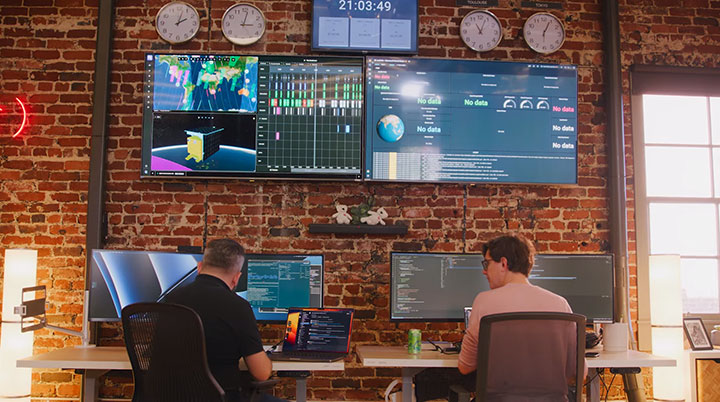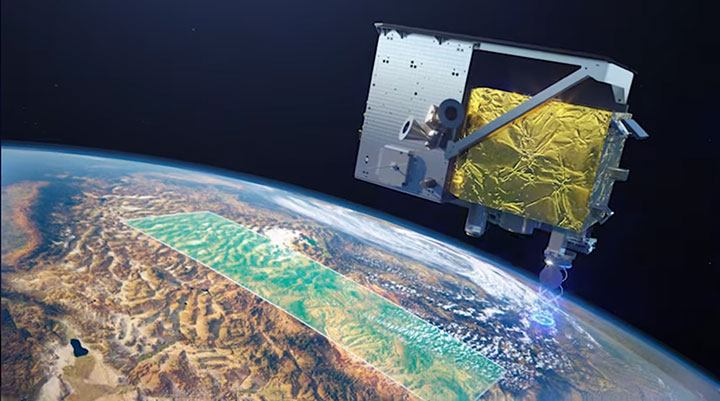 Loft Orbital’s virtual mission framework provides a set of standard APIs that allow a customer and developer to interact with any of YAM-6’s onboard sensors. (Source: Loft Orbital)
Loft Orbital’s virtual mission framework provides a set of standard APIs that allow a customer and developer to interact with any of YAM-6’s onboard sensors. (Source: Loft Orbital)
ALEXANDRIA, Va. — The satellite industry has been working collectively to bring space down to Earth by making on-orbit insights, data and connectivity more accessible. The software-as-a-service (SaaS) model for space that took off in the last decade embodies that trend. Rather than a customer owning and operating their own hardware, companies have sprung up offering satellite-as-a-service, ground station-as-a-service and space data-as-a-service with the goal of reducing the complexity and cost.
The next step in making space even more accessible could be on the horizon in the form of on-orbit infrastructure that allows software developers to use satellite resources to obtain real-time insights without managing the satellite or designing the payload. This concept is being pioneered by Loft Orbital through YAM-6, the industry’s first “virtual mission” satellite.
“What we’re doing with the YAM-6, which is unique, is we’re not flying any hardware for our customers,” explained Loft Orbital Co-founder and COO Alex Greenberg. Instead, he continued, “the customer is using Loft-owned resources on the satellite and deploying their own software onboard to orchestrate and use those resources.”
What is also unique about the concept is the development environment used to access satellite resources. Through a partnership with Microsoft Azure, software developers can access familiar tools and technologies in Microsoft’s cloud development environment to manage their virtual mission. In this way, Loft sees the potential for space applications expanding from a small number of space developers in cleanrooms to the millions of software developers already familiar with Azure tools.
According to Loft, developers using the Azure Orbital Space SDK (Software Development Kit) can access a framework, documentation and APIs to develop software. They are also given a test environment to validate applications and enable Loft to mitigate risks to the satellite.
“Right now, most people regard their satellite as somewhat of a walled garden—and for good reason, because they don’t want to introduce any potential bugs that could be fatal to their satellite,” said Greenberg.
The challenge was to ensure the security of the satellite and its payloads while abstracting away the complexity of the physical testbed for the developer, so all of the technology between the developer and the satellite is digital.
“What we’re really trying to do is lower the barrier to enable those developers to write software applications that can easily run onboard our satellite,” Greenberg said.
Virtual Missions Coming Soon
Loft Orbital has been focused on flying payload-as-a-service missions for customers since its founding in 2017. Greenberg has seen a strong market for both dedicated missions and rideshares. “But what expands the market is taking the burden of building or providing a payload away from the customer and just giving them access to payload hardware and compute that we already have in orbit.”
 Loft Orbital’s first satellite fully dedicated to virtual missions. YAM-6 is scheduled to launch in early 2024. (Source: Loft Orbital)
Loft Orbital’s first satellite fully dedicated to virtual missions. YAM-6 is scheduled to launch in early 2024. (Source: Loft Orbital)
The resources onboard YAM-6 include a hyperspectral imager, an RGB imager, a software-defined radio and an inter-satellite link data relay for real-time connectivity. The satellite will also have GPU, CPU and FPGA compute resources onboard that are capable of supporting AI applications. These resources are generally geared toward applications for object detection or change monitoring as well as autonomy. For example, a developer could create an application to detect a wildfire with a feature that tasks the satellite to track it continuously without communicating with the ground.
Currently, Loft has several customers lined up for YAM-6, including Microsoft, Agenium Space and Space Compass, a joint venture company between the Japanese information and communications technology leader NTT and SKY Perfect JSAT Corporation, Asia’s largest satellite operator.
The company has already conducted several virtual mission test flights on its YAM-3 and YAM-5 satellites. In the early stages of developing the concept of a virtual mission, customers approached Loft with a mission but little interest in building or buying their own payload. Loft was able to allocate excess sensor capacity on its owned payloads and provide limited computing power.
YAM-6 is scheduled for launch in early 2024 on the SpaceX Transporter-10 mission. Right now, it’s not clear what applications will be developed or what virtual missions YAM-6 will run. Loft says that’s the exciting part of its role. “Think of us as cloud infrastructure providers … but in space.”
Explore More:
Our Satellites Are Like Smartphones: Loft Orbital’s Alex Greenberg Explains
Podcast: New Accessibility to Space, Start-ups and a Changing Value Chain
The Implications of Increasing Earth Observation Data
